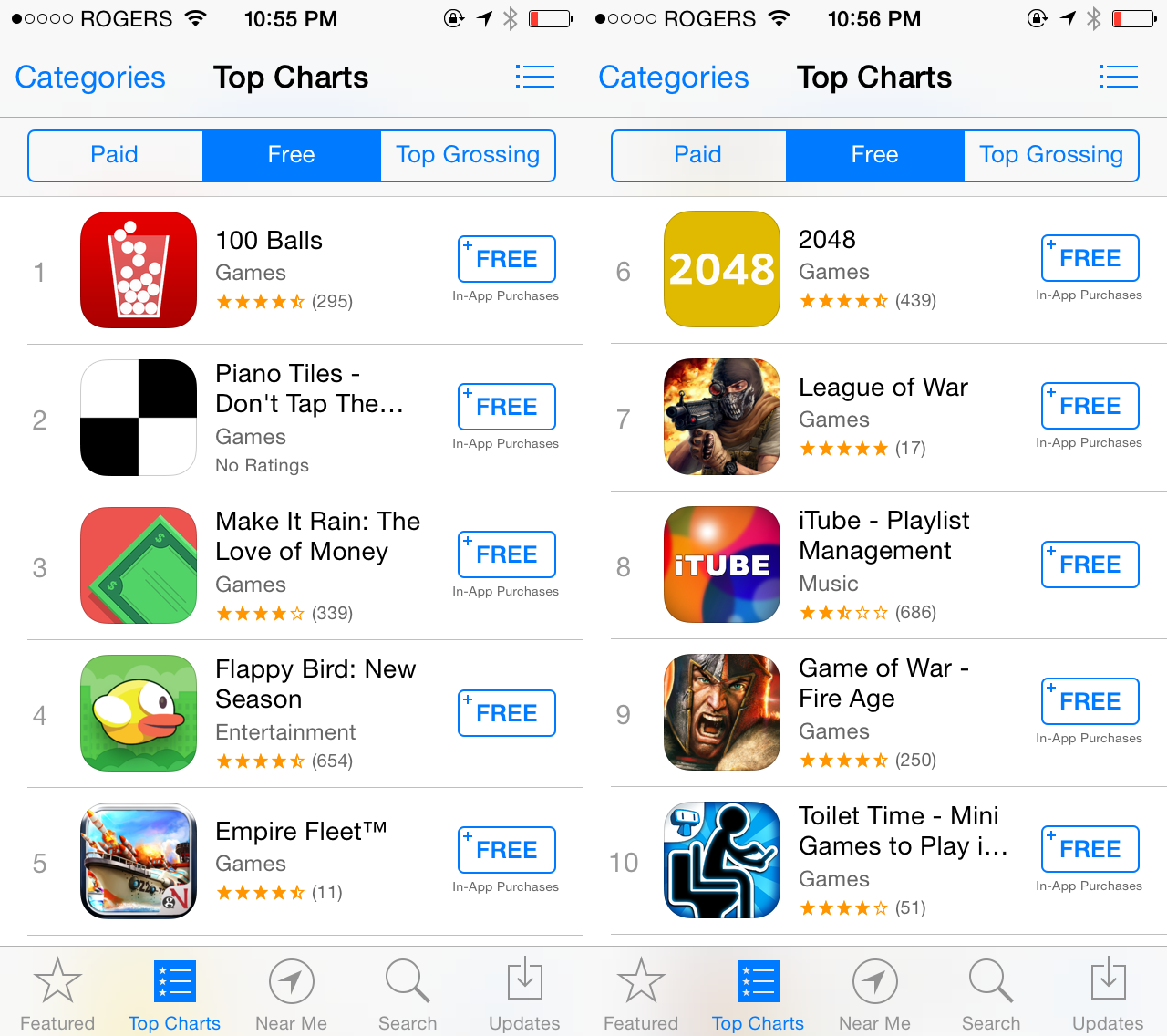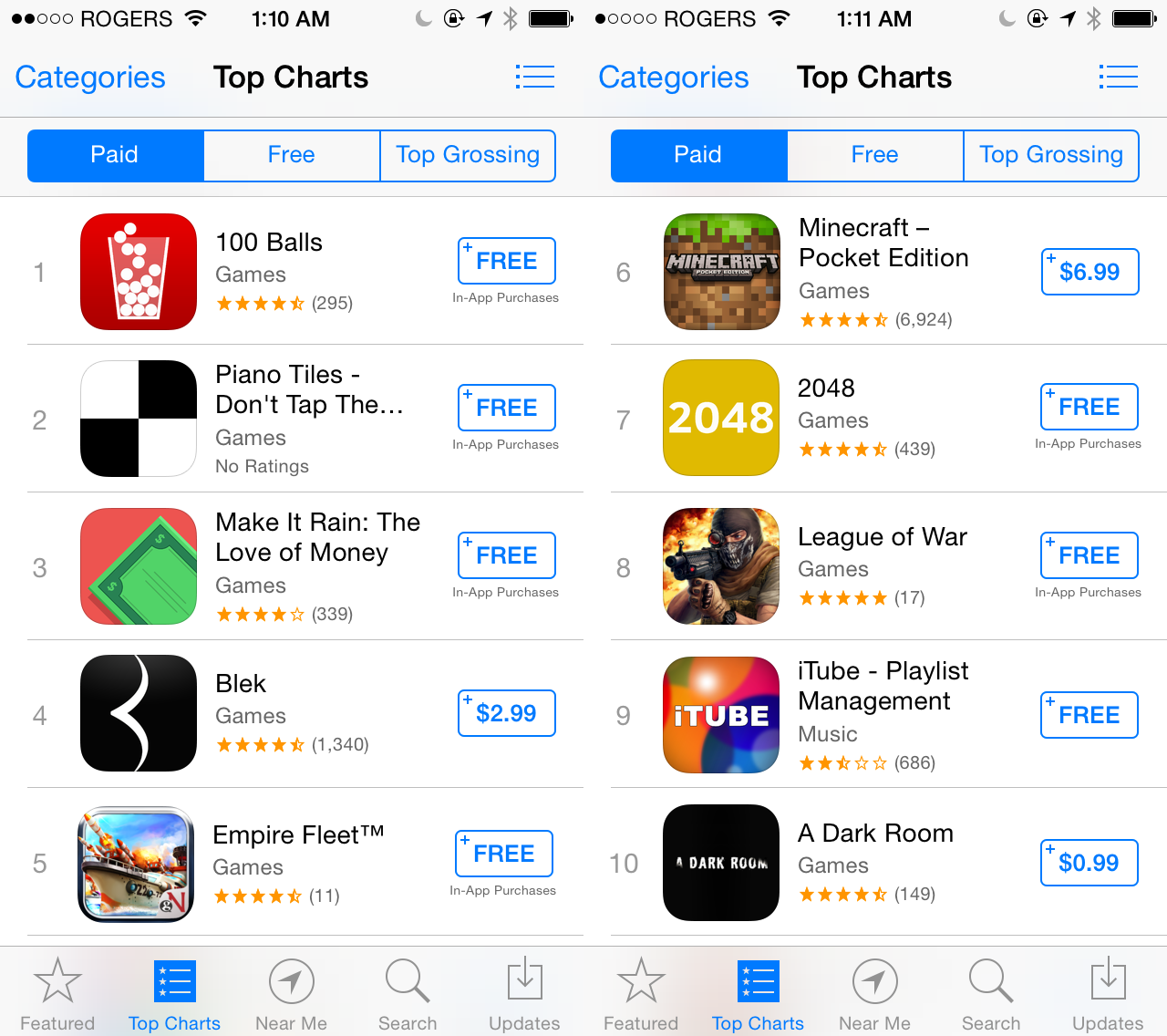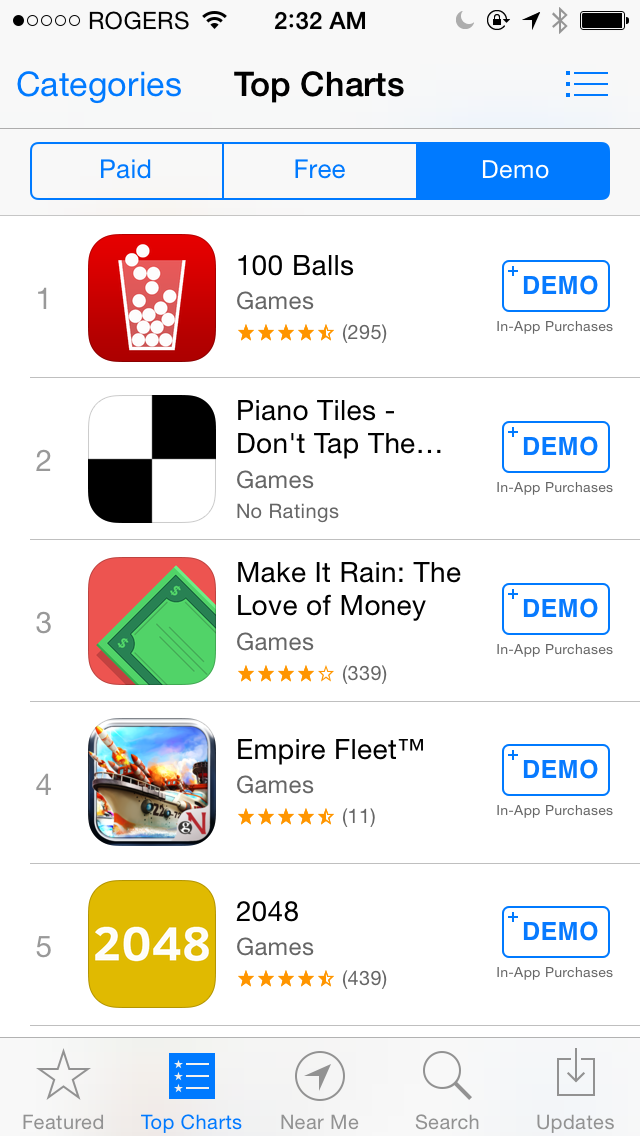Count the problems in this picture:
I count eight, not including my crying-out-for-a-lightning-cable battery life and the one-bar reception on Rogers.1
Eight of the top ten “Free” iPhone apps aren’t free at all. They contain in-app purchases. Apple even spells it out for us—in size 8-pt. Helvetica Neue, in text a shade darker than the white background, underneath big blue buttons that scream FREE.
These warnings, new as of iOS 7.1.1, are a welcome addition to the platform. (It only took an FTC investigation, $32-million in refunds, and a media backlash.) But they don’t address the problem of freemium creep on the App Store.
Apps with in-app purchases are still too easy to mistake for their free counterparts. They’re still cluttering up parts of the storefront where they don’t belong. And they’re more popular than ever, crowding out free and paid apps alike. None of those problems can be fixed with disclaimers.
It’s time for Apple to put its foot down and tell non-free apps where they belong. It’s time they were sent to the Freemium Ghetto.
Solution 1: Merge Freemium and Paid Apps
I don’t hate the freemium business model. Some companies wield in-app purchases for evil, but plenty of small developers have found well-deserved success by releasing their product for free with paid upgrades.
Freemium apps can be hugely effective, and that’s all the more reason why Apple needs to move them somewhere else. They’re are just too good at what they do. Their cost of entry—zilch—is just too compelling. They bulldoze everything in their path.
But where to put them? One possibility is to group freemium apps with paid apps. That way, consumers could browse the “Free” listings without having to worry about spending a cent, and all monetized apps would compete transparently and on the same level.
Here is what the App Store might look like if freemium and paid apps shared a single “Paid” list:
This setup might come across as more respectful of App Store browsers. But it’s got its problems. A merged list would be a slap in the face to developers of traditional paid apps. Only a handful would ever make it near the top ten when pitted against freemium competition.
Freemium developers wouldn’t be so thrilled with this arrangement either. They’d have to put up with the stigma of being called “Paid”. Nor would consumers be any less confused by the melange of payment options than they are now. Merging lists is a bad deal for everyone.
Solution 2: The Freemium Ghetto
A better solution requires a third type of app and a third category on the “Top Charts” screen. (The existing “Top Grossing” list would have to hit the chopping board, but that metric’s almost entirely meaningless for consumers anyway.) A new list would rise up—one where freemium apps could thrive:
The Freemium Ghetto.
All apps now belong to one of three types: Free, Paid, and Demo (freemium).2
This simple reorganization would improve the app-shopping experience immensely. Thanks to the Freemium Ghetto, “Free” would become a safe word on the App Store. There’d be no more need to question if that game you just impulse-downloaded wanted to sucker you in with hidden costs. Apps would wear their intentions on their sleeves. The App Store would feel less like the casino it resembles today.
More honest labeling would give paid apps more of a chance to succeed. Given the choice between an app labeled “FREE” and one that costs a buck, it’s obvious what most consumers will pick. But if the decision is between a demo of one app and a full version of another, the choice is more even-handed.
The Freemium Ghetto would be good news for freemium creators too—at least in the long run. They would avoid the kind of PR blow-ups that emerge when children (or childish adults) waste hundreds of dollars on an app or game they believed to be free. Parents would find the three-way distinction easier to understand than the existing choice between Paid, Free and “Free.”
By reserving the “FREE” label for those apps that truly deserve it, Apple would build consumer trust and confidence in its platform. That’s something all developers should want to see happen.
But the best part for developers? An exclusive category for apps with IAP would do wonders for exposure. No longer would freemium apps have to compete with free apps for positions in the rankings. In the Freemium Ghetto, the majority of them would be more visible than they are now.
These are all reasons why Apple should build the Freemium Ghetto. It might sound like kind of scary change that would make certain big name game publishers angry, but it’d be worth it.
Do it for your customers, Apple. Do it for your developer community. Do it the future of the App Store.
Agree? Not so much? Tell me: @mitchchn
-
For Americans: Pretend AT&T and Fox Broadcasting had a Canadian baby out of wedlock. That’s Rogers. One part Big Telecom, one part Big Media. ↩
-
I’m fond of the word “Demo” because of its connotations in the gaming world. Perhaps Apple could come up with a better moniker. It doesn’t matter. What matters is that there’s a clear separation between the three payment models on the App Store. ↩


